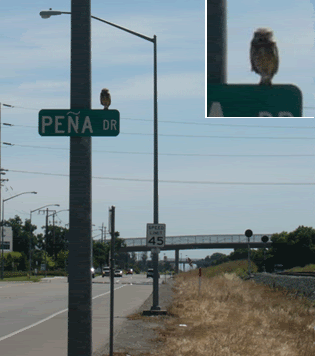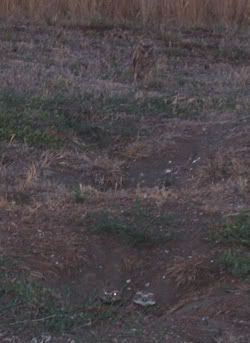Miervatian Burrowing Owl
Though tiny, the Miervatian Burrowing Owls are a predator, feeding on small rodents in the mountain valley regions in Mikitivity. They get their name from the burrows in which they live. They are the national animal of Mikitivity, and also well liked in many other nations (especially those which share owls as their national animals). They can be kept in captivity, and though it is legal to own a Miervatian Burrowing Owl in Mikitivity, it is frowned upon. As the national animal, the birds are protected by law in all of the cantons in Mikitivity.
Contents
Appearance
</div>Miervatian Burrowing Owls are small for owls and only slightly larger than songbirds such as the Den Jay. Adults have brown plumage with white spotting and a white belly. Their eyes and bill are yellow. Like most burrowing owls, Miervatian Burrowing Owls have long, powerful legs.
Owl chicks are proportioned similar to the adults, but their feathers are completely white. Typically they will molt, thus loosing their white feathers, around the same time that the snow cover begins to melt away. This winter "baby" coloring helps to hide the owl chicks from predators.
Habitat
Their long legs often lead people to believe that the owls actually burrow their own homes. However, the soils in their native habitat in the Thuvian mountains is often too hard for digging. Instead the owls have adapted to finding abandoned prairie dog and ground squirrel burrows to use as their own nests. The owls will bring mammal dung into their burrows, to help attract insects to feed on and to heat up the nest for the eggs or young owls.
The best time to spot a burrowing owl is between sunset and midnight, when they are actively hunting for food. Owls spotted during the day are often watching their nest or looking for a new nest. Mated pairs of owls are more likely to be spotted during the day.
The owls rarely nest near the banks of streams or rivers, preferring instead drier areas that are not subjected to occassional flooding. However, they will hunt in ravines and stream beds. Territorial in nature, the owls will nest several kilometers above creeks and streams and fly downhill to hunt for food. During the day they will tend to be close to their nest, leaving the drier upland territory at dusk to find insects or rodents near water.
Native Environment
Miervatian Burrowing Owls are native to the Thuvian and Solace mountains in the International Democratic Union. The largest number of owls can be found in the mid-elevations in the mountain valleys above the Risden River watershed, though owls have been seen as far to the east as Antrium and as far north as Keeslandia.
List of Countries where Miervatian Burrowing Owls are a native species:
Non-Native Locations
Due in part to their territorial nature, the burrowing owls have remained in their native environment. They rarely stray away from the mountains, were larger birds of prey are much more adept at competing with them for food. Unlike many other owls, Miervatian Burrowing Owls are also active during the day, usually digging or protecting their ground burrows.
List of Countries where Miervatian Burrowing Owls are an invasive species:
- unknown
Diet and Predators
The Miervatian Burrowing Owls feed on small rodents and insects during the night and rest during the day. A favorite food of the owls is the Drool Beattle, which the owls tend to roll around in the dust prior to eating. Owls in the Solace mountains do not eat the Solace Wisps that come out early in the evening. Though the owls will eat smaller rodents, they never prey on anything larger than themselves. When hunting, unlike most other owls, Miervatian Burrowing Owls will often stay on a single spot on the ground. The owls hunt alone, however, when not hunting mated pairs are often seen together.
Unlike other owls, burrowing owls also eat fruits and seeds. In doing so, the owls become an important part of the spread of some wildflowers such as Thuvian Chamomile. They tend to eat more seeds and fruits in the winter, and more insects in the summer.
The primary threat to the burrowing owls are human settlements, but in the growing suburbs of Miervatia City the owls have adapted to residential life with the support of conservation and preservation groups that design owl habitats under industrial buildings. These groups have found that the owls play an important role in controlling the rodent population.
Life Cycle
</div>The Miervatian Burrowing Owls like to mate in the fall. October through November the birds can be heard making all sorts of spooky clattering noises ranging from who who whos to clicking and hissing noises, designed to warn other owls of their presence and attract mates. The owls are usually monogamous, but in valleys where males are outnumbered, male birds will sometimes have two mates. The females never have more than one male mate.
The territories of mated pairs can overlap, but the mated pairs tend to ignore other burrowing owls. Only when a larger bird of prey or other predator enters overlapping territories, the burrowing owls tend to cooperate to frighten away the invader. When the threat is gone, the birds return to their individual burrows.
The owls are extremely territorial after eggs have been laid and until the chicks leave the nest. Male and female couples raise owl chicks together. Typically the male owl will stay behind with the chicks, while the female owl will bring food back to the nest (this is different than the way many other burrowing owls behave). Young owls are ready to fly about 2 lunar cycles after hatching. The parents will remain with the chicks for another 3 months teaching them how to hunt and dig.
A female can lay around 14 oves over a two week period. During this egg laying period, the nesting roles of the male and female owls will switch, and the male will bring food back to the nest and the female. These roles will remain unchanged until the chicks are born, at which time the female owl becomes the huntress while the male the sentry. It is believed that the switch in their roles helps keep both the female and male owls strong enough to weather the winter.
While most eggs hatch, only 4-6 of the chicks will survive to adulthood. After the winter solstice, the chicks will begin to explore around the nest, though unlike the parents, they will typically travel uphill in addition to downhill when hunting. By the beginning of Spring, most of the juvenille owls will entirely leave the nest and their parents behind, seeking new territory. Often the owls will find a new valley kilometers away from where they were raised. The adults however will often use the same nest several years in a row.
Long lived, Miervatian Burrowing Owls tend to live for at least 10 years in the wild and have lasted on average 25 years in captivity. Mated pairs do not lay eggs every year. When a valley or region becomes overpopulated by owls, instead of nesting, the mated pair will spend more time looking for a new nest, thus the population is self regulating.
Social Significance
Images of the small owls are frequently seen across the City States. They are the official animal of Mikitivity, and as such many companies (such as Eule Fluglinien), streets, buildings, and events are named after the owls. References to the birds pop up in mythological and cultural references frequently. Known to be quiet builder / hunters, the birds are thought to symbolise the qualities that most Mikitivians take pride in themselves.


